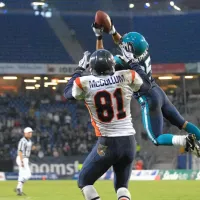West Ham is an inner-city district located in East London, England, specifically within the London Borough of Newham. It is situated approximately 6.1 miles (9.8 kilometers) east of Charing Cross, marking its position as an inner-city suburb.
1901: Ninth most populous district in England
At the time of the 1901 census it was the ninth most populous district in England with a population of 267,308.
1904: West Ham United F.C. played at the Boleyn Ground
West Ham United F.C. played at the Boleyn Ground in nearby Upton Park from 1904.
1907: West Ham Council Considered Inclusion in the County of London
In 1907 West Ham Council considered the case for inclusion in the County of London.
February 1915: West Ham Raised a Pals Battalion
In February 1915, the Mayor and Borough of West Ham raised a pals battalion of local volunteers, the 13th (Service) Battalion (West Ham) of the Essex Regiment, which first paraded at St Luke's Church in Canning Town.
February 1918: Battalion Disbandment
In February 1918, the West Ham battalion was disbanded due to manpower shortages in the British Army, with the surviving members reassigned to other battalions of the Essex Regiment.
1928: West Ham Stadium Operated
The West Ham Stadium, a football, greyhound racing and speedway stadium, operated from 1928.
1929: West Ham Hammers team in top flight leagues
The West Ham Hammers team were involved in the top flight leagues from 1929.
1934: Surrounded by County Borough of East Ham
From 1934 it was surrounded by the County Borough of East Ham to the east, the municipal boroughs of Wanstead and Woodford and Leyton to the north, and the metropolitan boroughs of Poplar to the west with the Thames to the south with Greenwich on the far side.
1939: West Ham Hammers team in top flight leagues
The West Ham Hammers team were involved in the top flight leagues until 1939.
1946: West Ham Hammers team in top flight leagues
The West Ham Hammers team were involved in the top flight leagues from 1946.
1955: West Ham Hammers team in top flight leagues
The West Ham Hammers team were involved in the top flight leagues until 1955.
1963: London Government Act
In 1965, under the terms of the London Government Act 1963, the county borough was abolished and its former area was amalgamated with small parts of Barking and Woolwich to form the London Borough of Newham in Greater London.
1964: West Ham Hammers team in top flight leagues
The West Ham Hammers team were involved in the top flight leagues from 1964.
1965: Surrounded by County Borough of East Ham
From 1934 to 1965 it was surrounded by the County Borough of East Ham to the east, the municipal boroughs of Wanstead and Woodford and Leyton to the north, and the metropolitan boroughs of Poplar to the west with the Thames to the south with Greenwich on the far side.
1965: West Ham Hammers team Won British League
In 1965 the West Ham Hammers team won the inaugural British League.
1965: Merged with neighbouring areas to become the western part of the new London Borough
In 1965, the parish and borough of West Ham merged with neighbouring areas to form the western part of the new London Borough.
1965: Abolishment of County Borough
In 1965, under the terms of the London Government Act 1963, the county borough was abolished and its former area was amalgamated with small parts of Barking and Woolwich to form the London Borough of Newham in Greater London.
1971: Non-European origin population
In 1971, individuals of non-European origin comprised approximately 16% of the population of West Ham.
1971: West Ham Hammers team in top flight leagues
The West Ham Hammers team were involved in the top flight leagues until 1971.
1972: West Ham Stadium Operated
The West Ham Stadium, a football, greyhound racing and speedway stadium, operated until 1972, with a capacity of 120,000.
March 1976: IRA Bombing at West Ham Station
In March 1976, an IRA terrorist planted a bomb on a Metropolitan Line train, which exploded prematurely at West Ham station, injuring seven. The perpetrator shot and killed the train driver, Julius Stevens, and then shot himself but survived.
1991: Non-European origin population
By the 1991 census individuals of non-European origin comprised approximately 30% of the population of West Ham.
2010: Docklands Light Railway
From 2010 West Ham station is served by the Docklands Light Railway.
2011: Non-European origin population
In the 2011 census individuals of non-European origin comprised approximately 65.5% of the population of West Ham.
2012: Regeneration associated with the 2012 Olympic Games
In 2012, West Ham experienced a degree of regeneration, partly associated with the Olympic Games.
2016: West Ham United F.C. played at the Boleyn Ground
West Ham United F.C. played at the Boleyn Ground in nearby Upton Park until 2016.
Mentioned in this timeline

Football is a family of team sports primarily involving kicking...
The modern Olympic Games are a leading international sporting event...

Trains are a connected series of vehicles traveling on railway...
England a constituent country of the United Kingdom occupies roughly...

The Greyhound is a sighthound breed primarily bred for coursing...
A parish is a territorial division within a Christian diocese...
Trending

2 months ago Glen Powell's SNL Promo Channels Christopher Walken, Goes Viral This Week

Caleb Wilson is a former American football tight end who played in the NFL He was drafted by the Arizona...

5 months ago Jessica Simpson Opens Up About Dating Post-Eric Johnson Divorce: A 'Rough' Experience

5 months ago Jon Bon Jovi and Dorothea to Speak at Power of Pink Fundraiser's 30th Year

8 months ago Sean Astin's 'The Goonies' Celebrates 40th Anniversary, Streaming Free, Sequel Rumors Add Excitement

Ricky Dene Gervais is an English comedian actor writer producer and director known for his significant contributions to television He...
Popular

Stranger Things created by the Duffer Brothers is a popular...

XXXTentacion born Jahseh Dwayne Ricardo Onfroy was a controversial yet...
Turning Point USA TPUSA is an American nonprofit organization founded...
The Kennedy Center Honors are annual awards recognizing individuals and...

Bernie Sanders is a prominent American politician currently serving as...

Candace Owens is an American conservative political commentator and author...